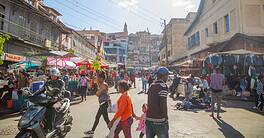The governor of the Bank of Italy shares thoughts with Global Finance.

Global Finance: The Covid-19 pandemic has taken a heavy toll on the Italian economy. The initial recovery has been better than expected. What are your forecasts for the Italian economy in 2020 and 2021?
Ignazio Visco: The diffusion of the new coronavirus has affected the Italian and the world economy very severely. The scale of this crisis is without parallel in recent history.
In Italy, in the first two quarters of this year GDP fell, cumulatively, by 17%, almost twice the loss recorded in the period 2008-13, which includes both the global financial crisis and the euro-area debt crisis, and which had been the worst slump in peacetime since Italy’s unification in 1861. Since May, with the gradual easing of the lockdown measures, some indicators have shown a partial recovery, broadly in line with our expectations. In our baseline scenario, which we have not yet revised, GDP is projected to decline by almost 10% in 2020 and to rise by less than 5% in 2021. Risks remain on the downside, especially because the pandemic is not evolving as many had hoped: Important countries are struggling to arrest the first wave of contagion; others are experiencing a second wave, with partial closures of economic activities. The situation is still worrying.
GF: What have been Italy’s benefits from the ECB’s large-scale quantitative easing [QE] programs?
Visco: After the outbreak of the pandemic, the ECB [European Central Bank] decided to strengthen its ongoing purchase programs and launch the new Pandemic Emergency Purchase Programme (PEPP) to counter the risks weighting on the monetary policy transmission mechanism and the outlook for the euro area. The PEPP was crucial in easing the tensions on financial markets that last March had led to a sharp increase in interest rates in all countries, and especially in Italy. The yield spread between Italian 10-year government securities and the corresponding German bund, which had been less than 140 basis points in February, widened to about 300 points toward mid-March. At the end of August it hovered around 150 points. The narrowing observed in the last months is comforting, but the spread remains too high and almost double those of Spain and Portugal. The sustainability of the Italian public debt is not in doubt. Still it is important to act immediately through a comprehensive package of reforms aimed at strengthening our economy also through a pragmatic and judicious use of European funds.
GF: Do you think the current recession may have a negative impact on the country’s bank balance sheets, increasing the amount of bad loans? What can be done to prevent this from happening or to lessen the problem?
Visco: Italian banks are facing the crisis from a stronger position than the one they were in before the double-dip recession of 2008-13. Between the start of 2007 and the start of 2020, the ratio of the highest quality capital to risk-weighted assets almost doubled, reaching 14%. Balance sheets have been cleared of a large part of their nonperforming loans, which have fallen by two thirds from their 2015 peak, to 3.2%.
Given the strength of the system before the crisis, European authorities have taken measures to encourage banks to use capital-and-liquidity buffers. Thanks to the liquidity injections by the eurosystem and the public guarantees on loans, intermediaries have been able to support the liquidity needs of households and firms.
Nevertheless, one legacy of the crisis will inevitably be an increase in nonperforming loans, which banks have to deal with in a timely manner using all available instruments, including restructuring and market sales. If necessary, we must stand ready to explore all the solutions to safeguard financial stability, like preventive tools to help banks that are facing severe but temporary difficulties and public support to indebted firms and households.
GF: What are the main risks for Italy and its economy?
Visco: After the exceptional drop in economic activity observed both in Italy and globally, a gradual recovery should characterize the remaining part of the year. However, a great deal of uncertainty surrounds the speed and intensity of the upturn and, more in general, the outlook for the following years. Risks are associated with a series of factors. The first is, as mentioned, the course of contagion, including the appearance of new outbreaks and the duration of the ensuing lockdown measures. The second is related to the possible persistent weakness of household and business confidence, which may continue to depress consumption and investment. A final risk concerns potential long-lived consequences of the pandemic on households’ habits, on the nature of work and, more in general, on the broad organization of our lives. If left unchecked, these transformations could increase hardship and inequality and, in turn, undermine the cohesion and sustainability of our society.



